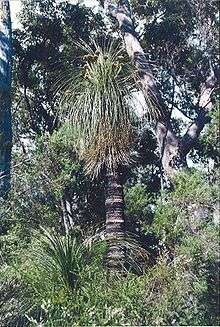Kingia
| Kingia | |
|---|---|
 | |
| Kingia australis at Fernhook Falls, Western Australia | |
| Scientific classification | |
| Kingdom: | Plantae |
| (unranked): | Angiosperms |
| (unranked): | Monocots |
| (unranked): | Commelinids |
| Order: | Arecales |
| Family: | Dasypogonaceae |
| Genus: | Kingia R.Br |
| Species: | K. australis |
| Binomial name | |
| Kingia australis R.Br | |
Kingia is a genus consisting of a single species, Kingia australis, and belongs to the plant family Dasypogonaceae,. It has a thick pseudo-trunk consisting of accumulated leaf-bases, with a cluster of long, slender leaves on top. The trunk is usually unbranched, but can branch if the growing tip is damaged. Flowers occur in egg-shaped clusters on the ends of up to 100 long curved stems. Kingia grows extremely slowly, the trunk increasing in height by about 1½ centimetres per year. It can live for centuries, however, so can attain a substantial height; 400-year-old plants with a height of six metres are not unusual.
When not flowering, Kingia australis bear a superficial similarity to species of the genus Xanthorrhoea, some of which bear the common name "blackboy" because of their purported similarity to an Aboriginal boy holding an upright spear. However, the flower stalks of Kingia australis are completely different from that of Xanthorrhoea species. Because of this, Kingia australis was for many years thought to be a female form of the blackboy and was commonly named black gin, a derogatory term for an Aboriginal woman*. This remains a widely known common name, but is considered inappropriate and belonging to the past. The genus name Kingia or the Aboriginal name bullanock are now preferred.
- The Noongar name for a woman is "yorga".[1] "Gin" is a shortened form of "Aborigine". Both these latter English language words are now considered offensive and racist.
Kingia and Xanthorrhoea are biologically quite distinct and are not closely related. For example, Xanthorrhoea have a secondary thickening meristem in the trunk (Dracaenoid secondary thickening meristem), whereas Kingia lack this feature.
Taxonomic history


Specimens of Kingia australis were first collected by Robert Brown at King George Sound in 1801. The plant featured in the drawing View of the south side of King George's Sound by expedition artist William Westall, which was later published as a plate in Matthew Flinders' 1810 A Voyage to Terra Australis; this is the first known image of the plant. A Voyage to Terra Australia also contained the first textual reference to this species: in the botanical index, Brown writes:
"A plant of a very similar habit to Xanthorrhoea, agreeing with it in its caudex and leaves, having, however, a very different inflorescence, was observed abundantly at King George's Sound, but with fructification so decayed and imperfect that I have not been able to determine the structure either of its flower or fruit."
Because of the state of decay of the fruit, Brown initially did not publish a name for the species. In 1823, however, William Baxter collected ripe fruit and seeds, specimens of which were passed to Brown. Based on these specimens, Brown published it in its own genus in his Character and description of Kingia, which first appeared as the botanical appendix to King's 1827 Narrative of a Survey of the Intertropical and Western Coasts of Australia performed between the years 1818 and 1822. The genus name was chosen to honour both King and his father Philip Gidley King, who was Governor of New South Wales during Brown's voyage under Flinders. The species epithet australis is Latin for "southern".
Distribution and habitat
Kingia australis is confined to the southern half of Western Australia.
References
- ↑ http://en.wiktionary.org/wiki/yorga. Missing or empty
|title=(help)
| Wikimedia Commons has media related to Kingia. |
| Wikisource has original text related to this article: |
| Wikispecies has information related to: Kingia |
| Wikispecies has information related to: Kingia australis |
- "Kingia australis". FloraBase. Western Australian Government Department of Parks and Wildlife.
- Powell, Robert; Emberson, Jane (1990). Leaf and Branch: Trees and Tall Shrubs of Perth. Department of Conservation and Land Management, Perth, Western Australia. ISBN 0-7309-3916-2..